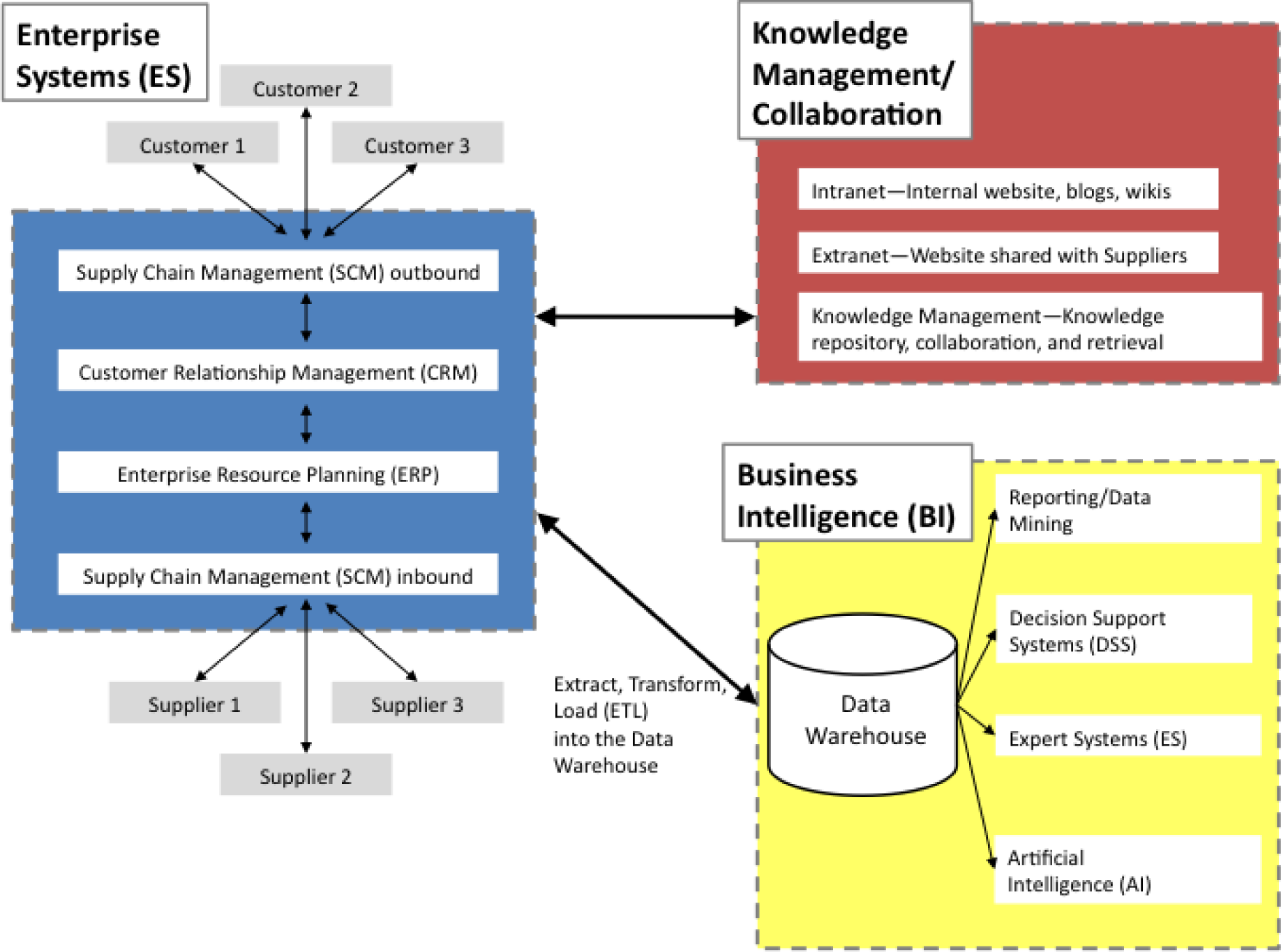This is “The Big Picture”, section 1.3 from the book Designing Business Information Systems: Apps, Websites, and More (v. 1.0). For details on it (including licensing), click here.
For more information on the source of this book, or why it is available for free, please see the project's home page. You can browse or download additional books there. To download a .zip file containing this book to use offline, simply click here.
1.3 The Big Picture
Learning Objective
- Compare and contrast Enterprise, Collaboration and Collaboration systems
Business Information Systems
Most information systems can be grouped into three broad classifications—enterprise systems (ES), knowledge management/collaboration systems, and business intelligence (BI) systems. These collectively comprise the information systems architectureThe high level view of corporate systems—usually divided into enterprise systems, knowledge management/collaboration systems and business intelligence systems. for an enterprise.
Enterprise systemsSystems that manage day to day transactions of the business. are used to manage the day to day business processes. Supply chain managementControlling the flow of raw materials and finished products into and out of the business. (SCM) controls inbound and outbound logistics. Customer relationship managementControlling communications with the customer to advance marketing goals (CRM) manages communications and marketing initiatives directed at customers. However, the grandaddy of them all are enterprise resource planningThe largest systems of all. ERP systems tie together all aspects of the business from accounting to the shop floor. (ERP) systems that control business transactions from accounts payable/receivable to product movement on the factory floor.
If this seems dense now, don’t worry about it. Books have been written about all these pieces. What is important for you to see is that ideally all the systems are smoothly coordinated so that management makes information driven decisions.
All of these enterprise systems communicate and share information as needed. They also store each of their activities in databases. At regular intervals these databases are copied into a centrally located data warehouse. The copying process is called extract, transform and load (ETL). Data is extracted from the multiple databases, transformed to a common format, and then loaded into the data warehouse.
The data warehouseA repository of corporate data collected from many corporate databases. then becomes a gold mine of data about the business. The beauty of the data warehouse is that it can be queried offline without interrupting operations of the business. However, the data warehouse is only as useful as the systems that query it for information. These are called business intelligenceThe process of analyzing data to spot trends and opportunities. (BI) systems. One of the most well known types of BI systems is for advanced reporting or data miningA form of BI that automatically looks for trends or patterns in the data.. BI systems look to spot trends in the data and then convey that information to the appropriate management level. For example, BI systems discovered years ago that diapers and beer were often purchased in the same supermarket visit. Clever marketing sleuths concluded that dad sent out to buy diapers was also picking up a 6 pack on his way out of the store. This creates opportunities for product placement—locating the beer closer to the diapers.
Knowledge managementCapture and index knowledge from past projects usually in text form. and collaboration systemsAllow multiple users to work on projects together—even when geographically separated. are ways that members of the organization capture and institutionalize organizational knowledge. The most familiar types of systems are internal websites for the company as well as blogs and wikis. However, leading organizations will also require that reports be filed in a systematic way to allow for easy retrieval in case the organization encounters a similar business problem in the future.

The big picture of information systems architecture. We will touch all these systems—albeit at a surface level. We will create a store that handles customer relationship management (CRM). Blackboard and similar systems are examples of collaboration systems. Finally, we will analyze our sales data as a form of business intelligence.
Key Takeaways
- Most business information systems can be classified as enterprise systems, collaboration systems, or business intelligence systems.
- Ideally all these systems smoothly exchange data to help managers make information driven decisions.
Questions and Exercises
- In Good to Great, Jim Collins quotes former Kroger CEO, Lyle Everingham, on how Kroger management made the decision to pursue the Superstore concept, “Basically, we did extensive research, and the data came back loud and clear: The super—combination stores were the way of the future.” Which of the information architecture systems could produce such data? Explain.




